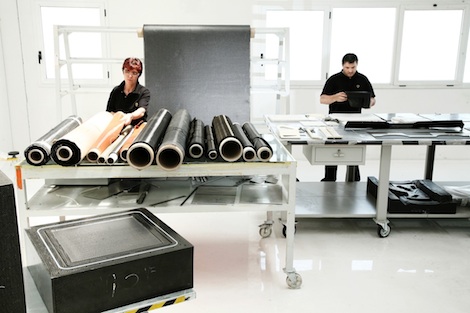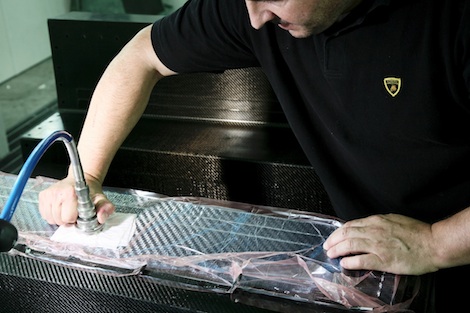Composites design is something that’s coming up a lot during my meetings with vendors. Only the other week I was looking at some simulation tools for simulation crack propagation across composite, multi-layered materials (that would be with the delightful chaps from Simulia when looking at Abaqus 6.10) as well as the composite design related tools in NX 7.5 from Siemens. Why the sudden concentration on composites? Facts are that these material types are becoming more and more commonplace outside of their traditional usage in Automotive. Only just this week the world’s first plastic plane (the Boeing 787) has landed on british soil for the first time at the Farnborough Airshow. Ok ok, it’s 50% carbon fibre but who can resist an overused cliche eh?.
Then an intriguing little press release popped into my inbox. It turns out that Automobili Lamborghini S.p.A has just opened a new Advanced Composites Research Center (ACRC) at its headquarters in Sant’Agata Bolognese, where the team will carry out research on innovative design and production methods for carbon-fibre elements. This has been built alongside development of an proprietary all-new, highly efficient production process for extremely complex carbon-fibre structures which has been “secured through an array of patents and constitutes a breakthrough into the next generation of carbon-fibre components.”
According to Lamborghini carbon fibre is crucial to the future. In fact, its CEO, Stephan Winkelmann, commented recently that “The consistent development of carbon-fibre technology is a key element of our strategy. The most important parameter for super sportscars is, now as in the future, the weight-to-power ratio; therefore, as there is a limit to power increase due to emission regulations, we must work on weight reduction. Extensive use of carbon fibre, even at structural level, allows Lamborghini to be at the forefront of development techniques. The real difference is in the correct use of technologies and materials to satisfy technical and financial concerns. This is what the Center is all about.”
If you take a look at the latest addition to the Gallardo stable, the LP 570-4 Superleggera, then you see why these materials are so important. compared with weight has been reduced by 70 kilograms (the thing only weighs 1340 kilograms in the first place – the majority of which is 5.2 litre power plant). Much of that saving has been made through the use of carbon fibre both on the interior and exterior.
Lamborghini has a lot of experience with these materials, in fact the Gallardo Spyder’s engine cover (pictured above) is the largest component ever produced in the automotive world. Interestingly, that component wasn’t built with the traditional Auto-clave based process, but rather using a much lower tech Resin Transfer Moulding (RTM) process which is impressive considering the class A surface quality. Technologies which move the reliance on costly auto-claves is a key focus for the new facility and is key to the new process the team of 30 engineer and technicians has developed. This “RTM light” process uses minimal pressure and relatively low temperatures to manufacture carbon-fibre components to the high levels of quality, precision and surface finish, from small parts to complex vehicle structures – and the process itself gives further benefits of higher process speeds, lower costs, and lightweight tooling.
Alongside production research, the company has also been heavily investing in simulation and this is the crux of my point. In 2009 along with Boeing, the company created the Automobili Lamborghini Advanced Composite Structures Laboratory (ACSL) at the University of Washington to research simulation and analysis technologies.
Composites are spreading their metaphorical wings and while we’re not going to see composite materials become the norm in the automotive world for sometimes, it’s becoming much more than a niche within a niche. Demand is rising (expectations are 8,5 million tonnes in five years time – http://www.textilesintelligence.com/til/press.cfm?prid=401). As the demand rises, the price drops, new lower cost processes come on line and it becomes a potential material for many more applications than it is currently. There’s also the “sustainability” angle. If you can save weight, you use less fuel. Whether that’s in fossil fuel powered vehicles or whatever comes next.
What’s interesting is that its clear that the smart vendors providing the tools with which these new products, new materials and new processes will be designed with are also gearing up their own understanding, taking knowledge from its ‘ahead of the curve” customers and creating a new set of tools that will help us understand these new tools in our toolkits. Exciting times indeed.










